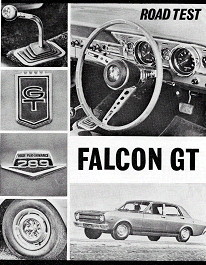
The Legend Begins
GT Information Article - 1

As the first article on Falcon GTs, I thought it appropriate to start with the model which started it all, the XR GT. The XR GT was introduced to the Australian public in April 1967 and was based on a ‘police special’ pursuit vehicle developed for the Victorian police force. The major purpose for the model’s introduction, was however to win the Gallaher 500 at Bathurst.
Ford had a very successful history at Bathurst, with the Cortina GT taking both line and class honours in 1963 & 1964, whilst the Harry Firth developed Cortina GT500 won again in 1965. Due to changes in the homologation rules, the Cortina GT500 was ruled ineligible in 1966, so Ford needed a new weapon to compete with in 1967, in this ever increasingly important annual event.
At this time, Ford had just introduced the XR Falcon range, which for the first time included a V8 option. With development of special V8 police “pursuit” vehicle well under way, Ford’s then Managing Director, Bill Bourke, saw an opportunity to develop this into a Bathurst contender, as well as giving the company an image leader in the growing youth market.
The job of transforming what was still basically just a family sedan, into a car capable of winning Australia’s toughest production car endurance race, was given to Don Dunoon, Malcolm Inglis and Harry Firth (the Silver Fox); the latter being so successful in not only developing the Cortina GT500, but also securing victories for Ford in racing and rallying.
The major mechanical changes made from the standard 289 cu.in. V8 model involved modifications to the engine, suspension, brakes and transmission. Using high crown pistons, which raised compression to 9.8 to 1, four barrel carburettor with chrome air cleaner, a revised camshaft profile and revised exhaust manifolds, the power of the engine was raised to 225 HP, whilst torque was raised to 305 ft/lbs.
Suspension modifications included a 16 to 1 steering box, stiffer front and rear springs, a bigger front stabiliser bar and 5½ ” steel rims with 185x14 Olympic GT radials. Brakes were 11” discs on the front and 10” drums on the rear, servo assisted. Transmission was the legendary Ford 4 speed “top-loader” mated to a 2.93 to 1 ratio diff.
The job of making the car look good, was given to Jack Telnac, Ford Australia’s first resident stylist. Externally, this included the “any colour you like, as long as its GT Gold” colour scheme, with GT badging, “side-winder” GT stripes, grille black-outs and chrome wheel covers.
Internally, the Fairmont based cabin was decked out in charcoal (not black) vinyl, Stewart Warner instruments, Hurst style manual gear shifter and Mustang style imitation wood rimmed steering wheel, with a big padded boss in the centre. In 1967, this was the trickest piece of gear around.
Performance figures for the XR GT varied from road test to road test, however top speeds indicated were generally over 120MPH, whilst the best standing quarter mile time given, was 15.8 sec. Not bad for a 1967 car that only cost $3,890 (inc. tax).
Although Ford initially only planned to produce 260 vehicles to meet the homologation requirements for Bathurst, demand was so great that more than double this amount were produced, before the next model GT was introduced. So unsure were Ford of the viability of a GT Falcon, that the first batch produced didn’t even have a handbook and the workshop manual supplement was included with that for the XT GT. The final figure however, is subject to debate but is around 684, with some of the unfilled orders being transferred to the XT GT.
As we know, the gamble to produce the Falcon GT paid off, with the Falcon GTs of Harry Firth/Fred Gibson and Leo and Pete Geoghegan taking out first and second places respectively. In winning the race, the Firth/Gibson car put in a fastest lap of 3min. 3sec. and was clocked down Conrod straight at 125.69MPH.
Some interesting facts about the XR GT that many people might not be aware of, include the fact that not all XR GT’s were painted GT gold. Eight were painted “Gallaher Silver” as promotional vehicles for the Gallaher cigarette company, the 1967 race winning car of Harry Firth and Fred Gibson was “Ivy Green” metallic, (as depicted in the Trax model), one was bronze, one was maroon and the remaining two were different shades of white. Also, some of the last XR GT’s produced had 302 motors instead of the 289 and rumour has it that there was also a factory automatic produced, supposedly last seen running around Brisbane.
At the 1997 Nationals – that being the 30th anniversary of the XR GT – Harry Firth was given the honour of being the guest speaker at the presentation dinner. Although he may have been getting on in years, Harry’s recollection of the time he helped Ford develop the GT Falcons, was as clear as ever.